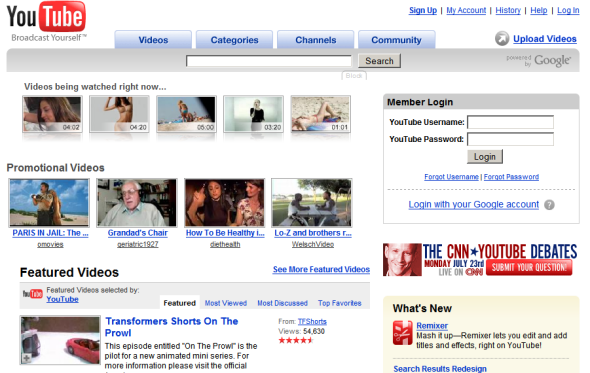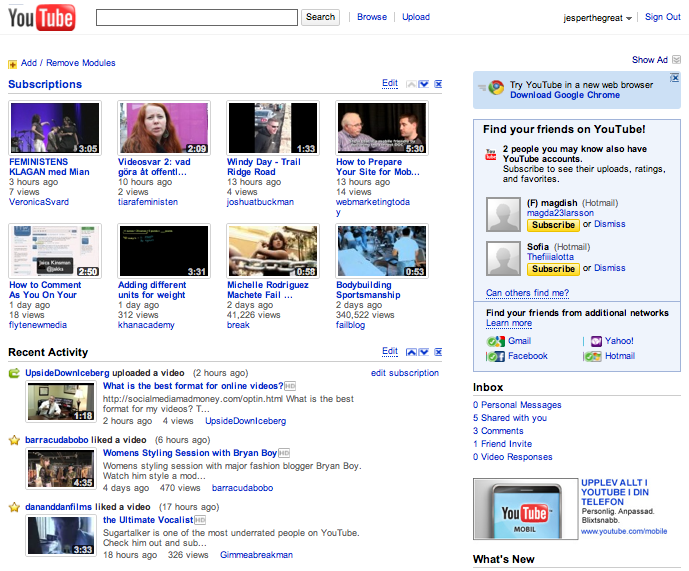When I look at marketing technology I have some things that I cannot do without:
- It should be fun
- It should be user friendly and accessible by most people
- It should be easy to measure
- It should be easy to share
- There should be a clear funnel from attention to attraction to purchase
YouTube has been yet another video website for many years. It has never been the best one, but it has, for most of the time, been the biggest one. It is just lately though, that they have changed the platform to actually suit the modern web and marketing environment that we’re living in, online today.
YouTube on YouTube.com
In the beginning, YouTube was a website located on YouTube.com. Sure, you could quite early embed the videos onto your own web platform, but the website YouTube was structured for viewing videos on YouTube. There were categories, there were video comments and ratings and there were quite sophisticated ranking models for search in the early days.
Google bought the thing and started indexing it in its Universal Search. For most this is quite a logical step as we sometime search for video material and possibly want it to be mixed with other stuff on the topic. But still, the YouTube.com platform didn’t change. It was still the same. Wanting users to search the website, or browse through the endless videos on the platform.
This is kind of odd as YouTube has known that about 80% of the video views occur elsewhere than on YouTube. Perhaps they were scared that people would stop using YouTube if they would change it. Possibly, they were low on staff and high on maintenance. Possibly they just didn’t care. The latter would be strange though as YouTube didn’t make any money. They bled insanely. So at least they needed to find a way to monetize on the fact that people were not visiting YouTube when watching the movies provided by YouTube-users through the platform.
YouTube goes Social
Then something happened, and it happened earlier this year. YouTube finally started making some changes. Not only in the most surprising way, when it connected to Facebook (considering it’s owned by Google), but it also started making changes to its analytics, to its embedded video formats and to its search/disposition.
YouTube started turning into a hub for social objects rather than a website. Think about it. First they added the new logged in view. In a very short period of time, and with out a lot of fuzz, YouTube turned from this:
Into this:
Never mind I am logged in on the second one of these images. It is quite the radical change and you really need to think about it when YouTube makes a change like this. They have adapted to the way the users use their website. The no longer rely on that people come to their website to browse categories. They believe people have a purpose when coming to the website, they believe that people subscribe to other peoples feeds, that they are given links, that they are interested in what other people they are interested in are doing, rather than just what is popular to the general crowd.
In a sense, YouTube has shrunk the scope of YouTube.com whilst they have opened up both its business model as well as its platforms to new ways of sharing. They have adapted to a dynamic, vibrant and social web rather than letting it exist in the static, navigational way a website works. It has become a resource hub, rather than being a website.
So why is this good for Online Marketeers?
Well, it is not if you are used to buying yourself out of trouble. But it is really good if you are creative. Even buying yourself out of the problem needs to be done creatively on YouTube nowadays. You can choose to cheat, naturally, but if you don’t, then you have to engage yourself in the websites content in order to become noticed. You cannot simply advertise yourself out of the mess, but you actually have to put something on the platform worth noting.
When I say that YouTube has turned social, I mean just that. As a marketeer you have no chance in marketing yourself on the YouTube platform any longer unless you choose to engage with the same means all other users are engaging. Videos, comments, likes, sharing.. … social stuff.
YouTube need not to worry as they are working with their branded channels, special access to neat analytics through integration with Google Analytics and other such things which makes marketing worth while. They are turning their business offer into something actually interesting for business. This wasn’t the case previously.
Annotations, linking videos together, subtitles and indexation, prominent placements of links, their wonderful API… all of which makes a digital creative go boner and a digital business developer to actually see a value in video production.
Business from YouTube
Now, the last statement in the last paragraph might meet some objections so I will argue why I believe that YouTube is better suited for business now that it has turned social.
First of all, your content has the ability to reach far beyond the static of website embeds. Even though discussion was previously made possible through comment fields, and sharing of links on social networks and blogs, it was a lot of hustle to do it. You actually needed a blog or a website in order to embed the stuff. Adding the post to wall functionality of comments, likes and all other interactive stuff you do on YouTube makes it spread a lot more easily and naturally. Thus the inbound reach of a YouTube video is greater today than previously, even without considering its content.
Secondly, using annotations and transcripts you can actually prompt the user to actions which was previously not possible. You can use the bottom third to push messages and you can use layovers to create call to action which suits the social web a lot better (as it is based on dialogue) than the old version of YouTube.
Third, and possibly most importantly, you can now measure and follow where your videos are being shared. Where is the discussion going on about you and your brand. Where do they use your tutorials as reference material and how can you in turn use these people to run your errands… I know… I shouldn’t say that… but that is really where all the dialogue turns to green. How can you make people talk about you in the way that you want them to. It is NOT about you wanting them to promote your offer. But IT IS all about making them talk about you in a way which is valuable to you.
Do they link to you? Do they use the latest version of the video? Do they spread rumors or facts?
Previously, you didn’t know this as dialogues weren’t on the web, but offline or in e-mail or on forums where YouTube embeds weren’t possible. But as you can measure it all from the YouTube interface it is finally easy to integrate into your other business practices.
I feel my arguments are pretty weak today… but I see increasing traffic from YouTube to my website. The traffic I get do all that I want them to on the website. I don’t even have to tell them. They read a lot of my blog posts, they sign up for everything, they visit my “contact me” page and some of them write e-mails to me asking questions. I think I will better structure the business value of YouTube in another post cause my inspiration just died…
Please add to this post below in the comments…
//Jesper
Possibly related posts:
- Related posts on YouTube goes social
- YouTube's new design and features
- YouTube Goes Social
- Related posts on YouTube new design
- YouTube's My Videos page gets a redesign. Can you see it yet?
- YouTube's new design and features



1 thought on “YouTube’s Change from Website to Hub for Social Objects”